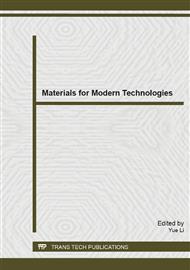[1]
A. Al-Hashem, A. Abdullah, W. Riad, Cavitation corrosion of nodular cast iron in sea water microstructural effects. Materials Characterization, 2001, 47: 383-388.
DOI: 10.1016/s1044-5803(02)00185-7
Google Scholar
[2]
E. Zumelzu, C. Cabezas, J. Sepu´ lveda, Influence of delta ferrite on the corrosion performance of welded 304 SS and 316 LSS joints in 6% ferric chloride solution, Protect. Met. 1998, 34 (6): 539–544.
Google Scholar
[3]
A. Kible, J.T.H. Pearce, Influence of heat treatment on the microstructure and hardness of 19% high chromium cast irons, Cast Met. 1993, 6 (1): 9–15.
DOI: 10.1080/09534962.1993.11819121
Google Scholar
[4]
R.L. Pattyn, Heat treatment of high-Cr white irons, AFS Trans. 1998, 98 (1): 161–167.
Google Scholar
[5]
L. Goyos, R. Castan˜eda, E. Wettinck, R. Valera, M. Moors, behaviour of nodular iron with austempering in corrosion and wear, in: Proc. IV Iberam. Congress of Mech. Eng., CIDIM'99, Vol. 1, Chile, 1999: 1–16.
Google Scholar
[6]
E. Fras, J.L. Serrano, A. Bustos, Cast Irons, Ed. ILAFA, Saltillo, Mexico, (1999).
Google Scholar
[7]
CollinsH H. corrosion resistance of cast iron[J]. BCIRA Journal, 1999: 11(5): 589-595.
Google Scholar
[8]
Lulian R. Carrasion resistance of cast iron[J]. Giessereitochnik, 1998: 34(3): 86-91.
Google Scholar
[9]
J.C. Scully, The fundamentals of corrosion, 3rd edn., Pergamon, Oxford, (1990).
Google Scholar
[10]
X.Y. Wang, D.Y. Li, Mechanical and electrochemical behavior of nanocrystalline surface of 304 stainless steel, Electrochim. Acta , 2002, 47: 3939.
DOI: 10.1016/s0013-4686(02)00365-1
Google Scholar
[11]
Kh.M.S. Youssef, C.C. Koch, P.S. Fedkiw, Improved corrosion behavior of nanocrystalline zinc produced by pulse-current electrodeposition, Corros. Sci , 2004, 46 : 51.
DOI: 10.1016/s0010-938x(03)00142-2
Google Scholar
[12]
J.C.S. Fernandes, R. Picciochi, M. Da Cunha Belo, T. Moura e Silva, M.G.S. Ferreira, I.T.E. Fonseca, Capacitance and photoelectrochemical studies for the assessment of anodic oxide films on aluminium, Electrochim. Acta , 2004, 49: 4701.
DOI: 10.1016/j.electacta.2004.05.025
Google Scholar
[13]
Y. Matsubara, N. Sasguri, K. Shimizu, Solidification and abrasion wear of white cast irons alloyed with 20% carbide forming elements, Wear, 2001, 250: 502–510.
DOI: 10.1016/s0043-1648(01)00599-3
Google Scholar
[14]
J.D. Xing, Y.M. Gao, E.Z. Wang, Effect of phase stability on the wear resistance of white cast iron at 800 ◦C, Wear, 2002, 252: 755–760.
DOI: 10.1016/s0043-1648(02)00015-7
Google Scholar
[15]
G.M. Goodrich, W.F. Shaw (Eds. ), Iron Castings Engineering Handbook, American Foundry Society, Des Plaines, IL, (2003).
Google Scholar
[16]
R.C. Juvinall, K.M. Marshek, Fundamentals of Machine Component Design, John Wiley & Sons Inc., (2000).
Google Scholar


